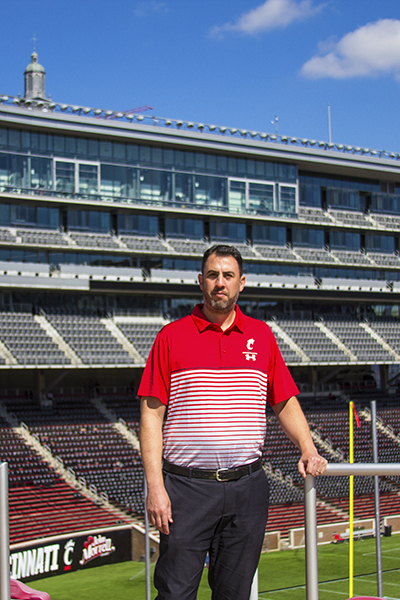|
Getting your Trinity Audio player ready...
|
Two Bearcats are better than one—since 2013, Associate Athletic Directors Andre Seoldo and Bill Frigge have worked to bring a sense of strength and unity to the University of Cincinnati’s athletic program despite the divisions in their roles and their disparate experiences with the university itself.
Seoldo and Frigge gave American Builders Quarterly an insider’s perspective on their collaborative dynamic and the pitch-in-where-help-is-needed approach that has seen them through construction-related upheaval and helped move the university’s facilities to a new level.
What brought you to the University of Cincinnati in the first place, and what has kept you there over the years?

Seoldo: I worked at Kent State for 10 years, working my way up the ladder and getting married during the process. In 2010, I shifted gears and took a job at the University of Northern Iowa, so we had to move our family out there. We enjoyed our time there and met some great people, but when a friend called me and told me that a position was going to be opening up with the University of Cincinnati, we made a family decision to come here. It got us closer to my wife’s family, and it also got me to the level of athletics I wanted to experience. Of course, I also saw some really exciting things on the horizon for the university.
Frigge: I started working for the university as a student in 1992 and the football team in 1993, so this is actually my 27th football season. I’ve moved around a bit—I spent three years in the college of music and got a master’s in criminal justice through the university’s online program. Because I’ve been here so long, I’ve grown up with a lot of the people here at the university. It’s been a great learning experience; this was a municipal university till the late ’70s, so watching the university go from where it was 20 years ago to what it is now has been exciting. Along with that, athletically we’re a completely different school than we were in the ’90s—my first football season, we were an independent football team, so we had to fight for the games that we scheduled and for people to respect us.
Could you provide some insight into your individual responsibilities as athletic directors and respective areas of expertise?
Seoldo: Every athletic department runs a little differently, and in the world of facilities and operations, it’s sometimes an even split. You need a group that handles the facilities and another to handle the events. My role encompasses the day to day as well as future scheduling and logistics of all the events that we host in our athletic facilities, including any championships. There’s a line that divides my work from Bill’s, but we cross that line quite a bit because we’re always willing to jump in and help each other.
Frigge: The university changed focus about eight years ago and decided that it’d be better served by having us take care of the operations and put another group in charge of facility maintenance. So I was able to focus more on projects and general facility issues rather than the upkeep of the building. I also took over the technology side of things—college athletics is all about technology now, and our conference just signed a deal with ESPN, so we will be producing our own content starting next summer.
Given that you have your own lanes within the athletic department, how do you and your teams work to collaborate and cooperate on bigger projects?
Seoldo: Bill and I have been at this for over 20 years now, so we’ve seen quite a lot. Between the two of us, we’ve got a lot of great experiences. So even if something is more in Bill’s wheelhouse than mine, he can still run it by me and I can do the same with him. It’s a kind of checks and balances system, just to make sure we are not missing anything.
Frigge: It’s not just Andre and me—anyone who works for us is capable of taking on any job or part of our operation. We jump around and cover for each other all the time, in a lot of different ways.

Portrait by Alex Ryan
Can you provide an example of when the department was facing a challenging situation and your collaborative approach helped you to overcome the problem?
Seoldo: I think the biggest challenge we’ve had in the last couple years is our major construction projects—we’ve had to take some of our venues offline and find new homes for our football, basketball, and volleyball teams, as well as our weight room. In addition to coordinating with the managers of the off-site venues those teams were using and providing Bearcat student athletes with the best possible experience, Bill and I also had to make sure that the day-to-day operations here at the university continued. Even though our teams were competing elsewhere, they still had practices and other everyday events and operations that had to happen here.
On top of those construction projects, are there any upcoming initiatives or projects that you’re excited about?
Frigge: The ESPN contract we have underway is going to bring us some fresh challenges for sure. It’s not just a matter of cameras—it’s equipment that has to be set up, people that have to be trained, and so much more. There will be plenty of challenges with that.
Seoldo: We have our rough days, of course, just like with any other job. But Bill and I both enjoy our jobs, and we enjoy working with each other. Everybody on our team keeps an eye on each other and has everyone else’s back. Bill and I have been around long enough to see the big picture and the benefits that we’re providing to our student athletes and the university.


